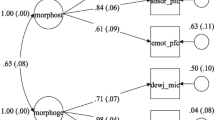Abstract
The Stability of Activities in the Family Environment (SAFE) measure was developed to assess aspects of the construct of family stability. An earlier version of the SAFE was revised to improve its psychometric properties and better elaborate the construct that underlies the measure. College students completed the revised SAFE and other measures of family functioning with respect to their families of origin and measures of current adjustment. Findings support the reliability, internal consistency, and factor structure of the SAFE. It is suggested that the results of the factor analyses and findings that different aspects of family stability demonstrated different patterns of relationships to indices of family functioning, are consistent with the presumption guiding the development of the SAFE that families achieve stability in diverse ways. The validity of the SAFE was further supported by its relationship to measures of current self-esteem and depression.
Similar content being viewed by others
REFERENCES
Beck, A. T., Epstein, N., Brown, G., &; Steer, R. A. (1988). An inventory for measuring clinical anxiety: Psychometric properties. Journal of Consulting and Clinical Psychology, 56, 893–897.
Beck, A. T., Steer, R. A., &; Garbin, M. G. (1988). Psychometric properties of the Beck Depression Inventory: Twenty-five years of evaluation. Clinical Psychology Review, 8, 77–100.
Beck, A. T., Ward, C. H., Mendelson, M., Mock, J., &; Erbaugh, J. (1961). An inventory for measuring depression. Archives of General Psychiatry, 4, 561–571.
Bennett, L. A., Wolin, S. J., &; Reiss, D. (1988). Deliberate family process: A strategy for protecting children of alcoholics. British Journal of Addictions, 83, 821–829.
Brody, G. H., &; Flor, D. L. (1997). Maternal psychological functioning, family processes, and child adjustment in rural, single-parent, African-American families. Developmental Psychology, 33, 1000–1011.
Bryant, F. B., &; Yarnold, P. R. (1995). Principal-components analysis and exploratory and confirmatory factor analysis. In L. G. Grimm &; P. R Yarnold (Eds.), Reading and understanding multivariate statistics (pp. 99–136). Washington, DC: American Psychological Association.
Creamer, M., Foran, J., &; Bell, R. (1995). The Beck Anxiety Inventory in a non-clinical sample. Behaviour Research and Therapy, 33, 477–485.
Fiese, B. H., &; Kline. C. A. (1993). Development of the Family Rituals Questionnaire: Initial reliability and validation studies. Journal of Family Psychology, 6, 290–299.
Francis, L. J., &; Wilcox, C. (1995). Self-esteem: Coopersmith and Rosenberg compared. Psychological Reports, 76, 1050.
Fergusson, D. M., &; Lynskey, M. T. (1995). Childhood circumstances, adolescent adjustment, and suicide attempts in a New Zealand birth cohort. Journal of the American Academy of Child and Adolescent Psychiatry, 34, 612–622.
Fiese, B. H. (1992). Dimensions of family rituals across two generations: Relation to adolescent identity. Family Process, 31, 151–162.
Fiese, B. H. (1997). Family context in pediatric psychology from a transactional perspective: Family rituals and stories as examples. Journal of Pediatric Psychology, 22, 183–196.
Hawkins, C. A. (1997). Disruption of family rituals as a mediator of the relationship between parental drinking and adult adjustment in offspring. Addictive Behaviors, 22, 219–231.
Israel, A. C., &; Roderick, H. A. (2001). A measure of the stability of family activities: An initial examination. Assessment, 8, 419–426.
Jaccard, J., &; Wan, C. K. (1996). LISREL approaches to interaction effects in multiple regression. Thousand Oaks, CA: Sage. (Sage University Paper series on Quantitative Applications in the Social Sciences, series no. 07-114.)
Jensen, E.W., James, S. A., Boyce, W. T., &; Hartnett, S. A. (1983). The Family Routines Inventory: Development and validation. Social Science and Medicine, 17, 201–211.
Jöreskog, K., &; Sörbom, D. (1999). LISREL 8.30 [Computer Software]. Lincolnwood: Scientific Software International.
Keltner, B. (1990).Family characteristics of preschool social competence among black children in a Head Start program. Child Psychiatry and Human Development, 21, 95–108.
Kliewer, W., &; Kung, E. (1998). Family moderators of the relation between hassles and behavior problems in inner-city youth. Journal of Clinical Child Psychology, 27, 278–292.
Larson, R. W., Richards, M. H., Moneta, G., Holmbeck, G., &; Duckett, E. (1996). Changes in adolescents' daily interactions with their families from ages 10 to 18: Disengagement and transformation. Developmental Psychology, 32, 744–754.
Masten, A. S., Morison, P., Pellegrini, D., &; Tellegen, A. (1990). Competence under stress: Risk and protective factors. In J. Rolf, A. S. Masten, D. Cicchetti K. H. Nuechterlein, &; S. Weintraub (Eds.), Risk and protective factors in the development of psychopathology. New York: Cambridge University Press.
Moos, R. H. (1986). Family environment scale manual (2nd ed.). Palo Alto, CA: Consulting Psychologists Press.
Moos, R. H. (1990). Conceptual and empirical approaches to developing family-based assessment procedures: Resolving the case of the Family Environment Scale. Family Process, 29, 199–208.
Patterson, G. R., Forgatch, M. S., Yoerger, K. L., &; Stoolmiller, M. (1998). Variables that initiate and maintain an early-onset trajectory for juvenile offending. Development and Psychopathology, 10, 531–547.
Rosenberg, M. (1965). Society and the adolescent. Princeton, NJ: Princeton University Press.
Sandler, I., Wolchik, S. A., Braver, S. L., &; Forgas, B. S. (1991). Stability and quality of life events and psychological symptomatology in children of divorce. American Journal of Community Psychology, 19, 501–520.
Stoneman, Z., Brody, G. H., Churchill, S. L., &; Winn, L. L. (1999). Effects of residential instability on Head Start children and their relationships with older siblings: Influences of child emotionality and conflict between caregivers. Child Development, 70, 1246–1262.
West, S. G., Sandler, I., Pillow, D. R., Baca, L., &; Gersten, J. C. (1991). The use of structural equation modeling in generative research: Toward the design of a preventive intervention for bereaved children. American Journal of Community Psychology, 19, 459–480.
Wolin, S. J., Bennett, L. A., &; Noonan, D. L. (1979). Family rituals and the recurrence of alcoholism over generations. American Journal of Psychiatry, 136, 589–593.
Author information
Authors and Affiliations
Corresponding author
Rights and permissions
About this article
Cite this article
Israel, A.C., Roderick, H.A. & Ivanova, M.Y. A Measure of the Stability of Activities in a Family Environment. Journal of Psychopathology and Behavioral Assessment 24, 85–95 (2002). https://doi.org/10.1023/A:1015336707701
Issue Date:
DOI: https://doi.org/10.1023/A:1015336707701




